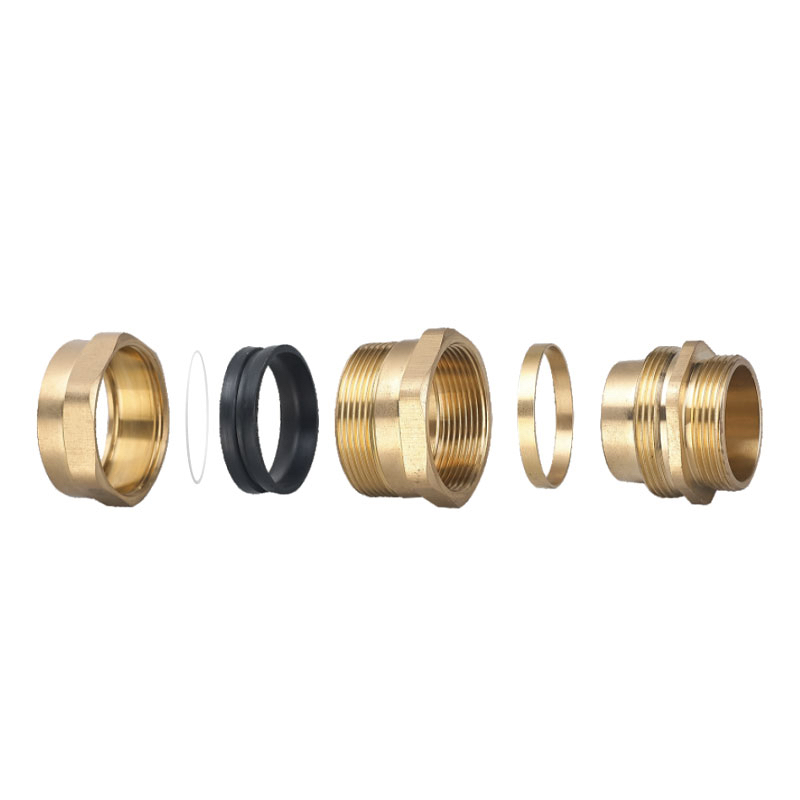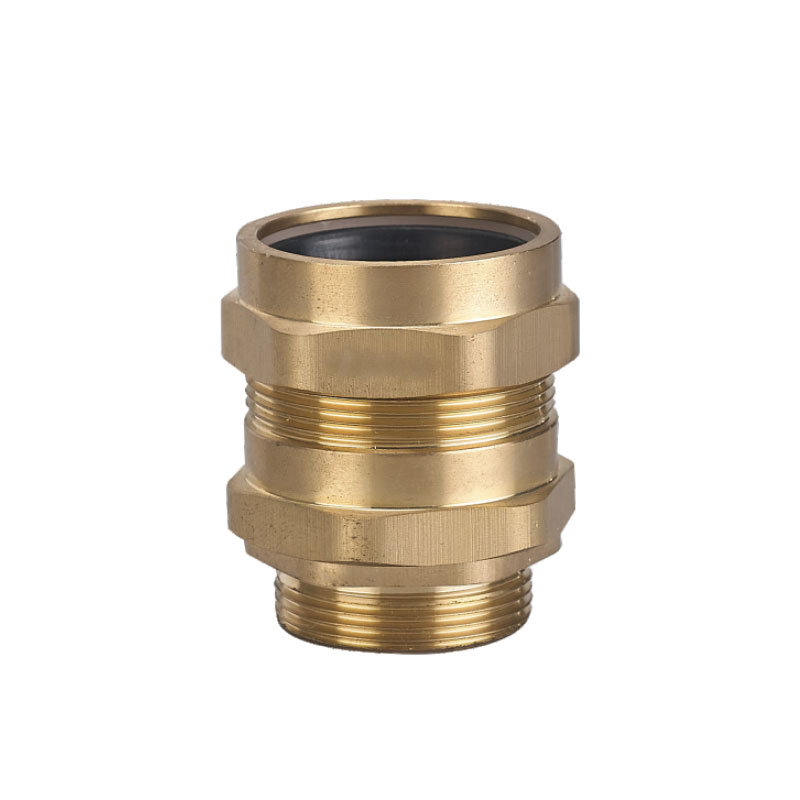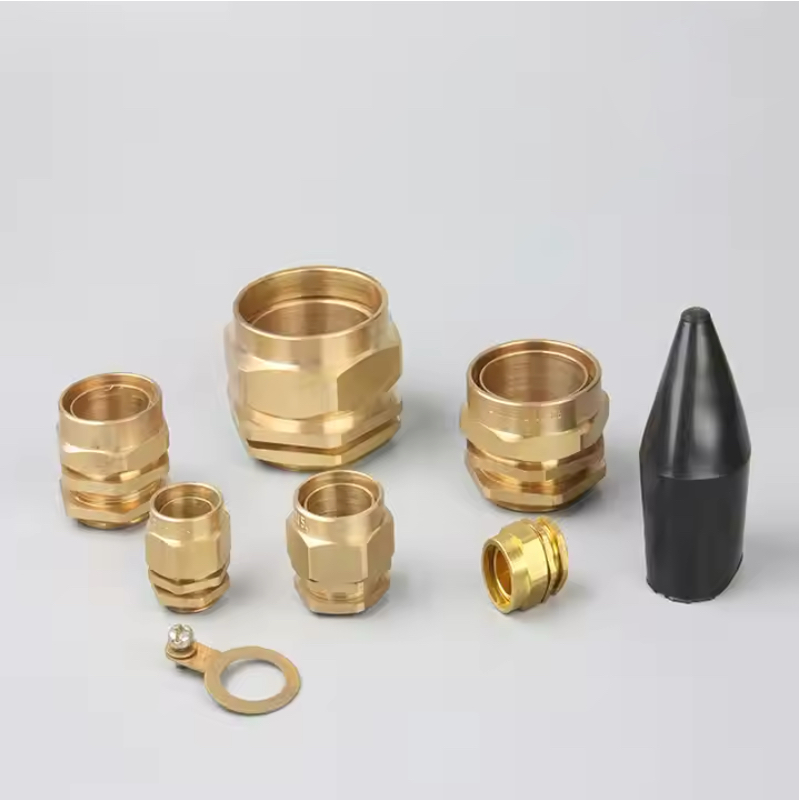Understanding the intricate construction of A2 type brass cable glands is crucial for engineers and procurement managers who need reliable cable termination solutions. Many professionals struggle with selecting the right cable gland specifications without fully understanding the internal construction and how each component contributes to overall performance.
Латунные кабельные вводы типа A2 имеют прочную многокомпонентную конструкцию, включающую латунный корпус с метрической резьбой, систему компрессионного уплотнения, механизм разгрузки от натяжения и встроенный заземляющий проводник. Они разработаны специально для оконцевания бронированных кабелей с защитой от воздействия окружающей среды IP68 и механической прочностью для промышленных применений, требующих долговременной надежности.
Just last month, Robert, a project engineer from a manufacturing facility in Birmingham, UK, contacted me after experiencing seal failures with inferior cable glands. His team needed to understand the precise construction differences between A2 type brass glands and standard versions to prevent costly equipment downtime in their automated production lines 😉
Оглавление
- What Makes A2 Type Brass Cable Glands Unique?
- How Are the Key Components Constructed?
- What Materials and Manufacturing Processes Are Used?
- How Does the Sealing System Work?
- What Are the Quality Standards and Testing Requirements?
- FAQs About A2 Type Brass Cable Gland Construction
What Makes A2 Type Brass Cable Glands Unique?
The A2 designation represents a specific construction standard that differentiates these cable glands from other types in terms of design philosophy and application focus.
A2 type brass cable glands are specifically engineered for armored cable termination with enhanced mechanical strength, featuring a specialized construction that includes armor clamping mechanisms, extended thread engagement, reinforced body design, and superior earthing continuity1 compared to standard cable glands, making them ideal for heavy-duty industrial applications.
Design Philosophy and Standards
A2 Construction Standards:
- Enhanced mechanical strength requirements
- Specialized armored cable accommodation
- Extended service life specifications
- Superior environmental protection ratings
- Integrated earthing and bonding capabilities
Key Differentiating Features:
- Reinforced body wall thickness (minimum 2.5mm)
- Увеличенная длина зацепления резьбы
- Specialized armor clamping system
- Enhanced sealing performance
- Превосходная коррозионная стойкость
Construction Specifications
| Компонент | A2 Type Specification | Стандартный тип |
|---|---|---|
| Body Wall Thickness | 2.5-4.0mm | 1.5-2.5mm |
| Обручение нити | 8-12 threads minimum | 5-8 threads |
| Sealing Rings | Dual compression system | Single seal |
| Зажим для брони | Integrated design | Optional/separate |
| Класс материала | CW617N/CW614N2 | CW617N standard |
| Рейтинг IP | IP68 guaranteed | IP65-IP67 typical |
Application-Specific Design Elements
Armored Cable Optimization:
- Specialized armor wire accommodation
- Integrated armor clamping mechanism
- Enhanced strain relief design
- Superior earthing continuity
- Mechanical protection features
Industrial Environment Adaptation:
- Vibration resistance construction
- Temperature cycling durability
- Химическая стойкость
- UV stability for outdoor use
- Устойчивость к механическим воздействиям
Преимущества производительности
Enhanced Reliability:
- 25+ year service life expectation
- Superior environmental sealing
- Снижение требований к техническому обслуживанию
- Consistent performance under stress
- Предсказуемые режимы отказа
Эксплуатационные преимущества:
- Simplified installation procedures
- Reduced inventory complexity
- Снижение общей стоимости владения
- Повышенная надежность системы
- Enhanced safety performance
At Bepto, our A2 type brass cable glands undergo rigorous quality control processes in our CNC machining facilities. We maintain strict dimensional tolerances and material specifications to ensure consistent performance across all production batches.
How Are the Key Components Constructed?
Each component of an A2 type brass cable gland serves a specific function and requires precise manufacturing to achieve optimal performance.
A2 type brass cable glands consist of seven primary components: the main body with metric threads, compression nut, sealing washers, compression cone, armor clamp ring, earthing tag, and strain relief boot, each manufactured to precise tolerances using specialized machining processes and quality-controlled brass alloys for maximum durability and performance.

Main Body Construction
Body Design Features:
- CNC-machined from solid brass bar stock
- Metric thread specification (M12-M75 range)
- Integrated sealing surfaces with precise finish
- Internal cable accommodation chamber
- Armor wire termination area
Процесс производства:
- Computer-controlled turning operations
- Thread rolling for superior strength
- Surface finishing to Ra 1.6 specification
- Dimensional inspection at multiple stages
- Final assembly preparation
Compression System Components
Compression Nut Design:
- Hexagonal external profile for tool engagement
- Internal compression thread system
- Integrated sealing surface preparation
- Torque specification optimization
- Anti-seizing surface treatment
Sealing Washer Construction:
- EPDM rubber compound selection
- Shore A hardness 70±5 specification
- Temperature range -40°C to +125°C
- Химическая стойкость
- Устойчивость к сжатию
Armor Clamping Mechanism
Armor Clamp Ring Features:
- Serrated internal surface for wire grip
- Tapered design for compression action
- Corrosion-resistant surface treatment
- Precise dimensional control
- Integration with earthing system
Earthing Tag Construction:
- Brass or stainless steel material
- M4 or M5 earthing screw provision
- Low-resistance electrical path
- Corrosion protection coating
- Mechanical strength verification
Strain Relief System
Boot Design Elements:
- Flexible elastomer material selection
- Graduated flexibility zones
- Cable diameter accommodation range
- Environmental protection properties
- Long-term durability characteristics
Технические характеристики:
- Bend radius protection: 6x cable diameter
- Temperature stability: -40°C to +100°C
- UV resistance for outdoor applications
- Oil and chemical resistance
- Fatigue resistance testing
Меры контроля качества
Проверка компонентов:
- Dimensional verification using CMM
- Анализ состава материала
- Измерение шероховатости поверхности
- Thread gauge verification
- Assembly fit testing
Проверка работоспособности:
- Torque testing for proper assembly
- Sealing performance verification
- Проверка непрерывности электрического тока
- Environmental exposure testing
- Long-term durability assessment
Ahmed, who manages electrical installations for a petrochemical facility in Dubai, UAE, required detailed component specifications for his ATEX Zone 1 applications. Our engineering team provided comprehensive construction drawings and material certificates, enabling his team to achieve full regulatory compliance with superior long-term performance.
What Materials and Manufacturing Processes Are Used?
The selection of materials and manufacturing processes directly impacts the performance, durability, and cost-effectiveness of A2 type brass cable glands.
A2 type brass cable glands utilize CW617N or CW614N brass alloys for the main body, providing excellent corrosion resistance and machinability, with EPDM sealing materials, stainless steel hardware, and specialized surface treatments, manufactured using precision CNC machining, thread rolling3, and automated assembly processes to ensure consistent quality and performance.
Primary Material Selection
Brass Alloy Specifications:
- CW617N (58% copper, 39% zinc, 2% lead)
- CW614N (58% copper, 39% zinc, 3% lead)
- Excellent corrosion resistance properties
- Superior machinability characteristics
- Optimal strength-to-weight ratio
Свойства материала:
- Tensile strength: 380-420 MPa
- Yield strength: 140-180 MPa
- Elongation: 15-25%
- Hardness: 80-120 HB
- Electrical conductivity: 26-28% IACS
Sealing Material Technology
EPDM Rubber Characteristics:
- Ethylene Propylene Diene Monomer base
- Shore A hardness 70±5
- Temperature range: -40°C to +125°C
- Excellent ozone resistance
- Superior weathering properties
Alternative Sealing Materials:
- NBR for oil resistance applications
- Viton for chemical resistance
- Silicone for extreme temperatures
- TPE for food-grade applications
- Custom compounds for specific needs
Manufacturing Process Overview
CNC Machining Operations:
- Computer-controlled turning centers
- Multi-axis machining capabilities
- Automated tool changing systems
- Real-time dimensional monitoring
- Статистическое управление процессами
Thread Manufacturing:
- Thread rolling for superior strength
- Precise pitch and profile control
- Оптимизация качества поверхности
- Проверка точности размеров
- Thread gauge inspection
Surface Treatment Processes
Защита от коррозии:
- Nickel plating for enhanced durability
- Chromium plating for wear resistance
- Пассивирующая обработка
- Organic coating systems
- Specialized marine coatings
Quality Enhancement:
- Surface roughness control
- Dimensional stability improvement
- Appearance standardization
- Оптимизация производительности
- Долговечность
Quality Assurance Systems
Сертификация материалов:
- Mill test certificates for all materials
- Chemical composition verification
- Mechanical property testing
- Документация по прослеживаемости
- Программы квалификации поставщиков
Управление процессом:
- Statistical process monitoring
- Automated inspection systems
- Программы непрерывного совершенствования
- Процедуры корректирующих действий
- Интеграция отзывов клиентов
At Bepto, we maintain strict material traceability from raw material receipt through final product delivery. Our ISO9001 and IATF16949 certifications ensure consistent quality and continuous improvement in our manufacturing processes.
How Does the Sealing System Work?
The sealing system is the most critical aspect of A2 type brass cable gland construction, determining environmental protection and long-term reliability.
A2 type brass cable glands employ a dual-compression sealing system featuring primary cable sealing through radial compression of EPDM washers against the cable jacket, and secondary environmental sealing via thread-mounted O-rings, creating IP68 protection through controlled compression forces that maintain seal integrity across temperature variations and mechanical stress.
Primary Sealing Mechanism
Cable Jacket Sealing:
- Radial compression against cable outer jacket
- Равномерное распределение давления по окружности
- Accommodation of cable diameter variations
- Compensation for thermal expansion/contraction
- Long-term seal integrity maintenance
Compression Force Control:
- Calculated compression ratios for optimal sealing
- Torque specifications for consistent results
- Over-compression prevention mechanisms
- Under-compression indication systems
- Field verification procedures
Secondary Environmental Sealing
Thread Sealing System:
- O-ring seals in thread engagement area
- Protection against ingress through threads
- Redundant sealing for critical applications
- Maintenance accessibility features
- Долгосрочная стабильность производительности
Sealing Performance Characteristics:
- IP68 rating verification testing
- Pressure resistance up to 10 bar
- Характеристики температурной цикличности
- Химическая стойкость
- UV degradation resistance
Sealing Material Performance
EPDM Sealing Properties:
- Отличная устойчивость к сжатию
- Wide temperature operating range
- Superior ozone and weather resistance
- Chemical compatibility with most cables
- Long-term aging characteristics
Тестирование производительности:
- Accelerated aging tests at elevated temperatures
- Compression set testing per ASTM D395
- Оценка химической стойкости
- UV exposure testing
- Thermal cycling verification
Installation Critical Factors
Proper Assembly Techniques:
- Требования к подготовке кабеля
- Sealing washer positioning
- Compression nut torque specifications
- Критерии визуального контроля
- Performance verification methods
Распространенные ошибки при установке:
- Insufficient cable preparation
- Incorrect sealing washer orientation
- Over-tightening causing seal damage
- Загрязнение при сборке
- Inadequate performance verification
Maintenance and Service Life
Seal Inspection Requirements:
- Visual inspection for damage or degradation
- Torque verification procedures
- Performance testing methods
- Критерии и процедуры замены
- Требования к документации
Expected Service Life:
- 20+ years under normal conditions
- 15+ years in harsh environments
- 10+ years in extreme chemical exposure
- Temperature cycling impact assessment
- Predictive maintenance indicators
The sealing system design has been validated through extensive testing at our facilities, including 1000-hour salt spray exposure, thermal cycling from -40°C to +125°C, and long-term compression set testing to ensure reliable performance throughout the product lifecycle.
What Are the Quality Standards and Testing Requirements?
A2 type brass cable glands must meet stringent quality standards and undergo comprehensive testing to ensure reliable performance in demanding applications.
A2 type brass cable glands must comply with IEC 62444, IP68 environmental protection standards, ATEX directive requirements for hazardous areas, and various national standards including BS, DIN, and ANSI specifications, with mandatory testing including ingress protection verification, mechanical strength testing, corrosion resistance evaluation, and electrical continuity measurement to ensure consistent quality and performance.
Соответствие международным стандартам
Primary Standards:
- IEC 62444: Кабельные вводы для электроустановок
- IEC 60529: IP protection degree classification
- IEC 60079: Explosive atmospheres equipment
- ISO 9001: Quality management systems
- IATF 16949: Automotive quality standards
Regional Standards:
- BS EN 50262: European cable gland standards
- DIN VDE 0619: German electrical installation standards
- ANSI/UL 514B: North American conduit fittings
- JIS C 8480: Japanese electrical equipment standards
- GB/T 5095: Chinese connector standards
Mandatory Testing Procedures
Environmental Protection Testing:
- IP68 ingress protection verification
- Continuous immersion testing (1m depth, 24 hours)
- Dust ingress prevention testing
- Характеристики температурной цикличности
- Оценка устойчивости к влажности
Mechanical Performance Testing:
- Tensile strength testing (minimum 500N)
- Torque resistance verification
- Испытание на ударопрочность
- Vibration endurance testing
- Fatigue cycle testing
Material Quality Verification
Chemical Composition Analysis:
- Spectroscopic analysis of brass alloys
- Lead content verification for RoHS compliance
- Trace element identification
- Material certification documentation
- Supplier qualification verification
Испытания механических свойств:
- Tensile strength measurement
- Определение предела текучести
- Elongation percentage testing
- Hardness verification (Brinell/Vickers)
- Impact resistance evaluation
Стандарты электрических характеристик
Требования к испытаниям на непрерывность:
- Earth continuity resistance measurement
- Contact resistance verification
- Испытание на сопротивление изоляции
- Dielectric strength testing
- EMC shielding effectiveness
Технические характеристики:
- Earth continuity: <0.1 ohm maximum
- Insulation resistance: >100 MΩ minimum
- Dielectric strength: 2000V AC minimum
- Shielding effectiveness: >60dB typical
- Temperature coefficient stability
Процедуры контроля качества
Проверка поступающих материалов:
- Material certification verification
- Dimensional inspection sampling
- Измерение шероховатости поверхности
- Chemical composition spot checking
- Supplier performance monitoring
Контроль качества производства:
- Внедрение статистического управления процессами
- Real-time dimensional monitoring
- Assembly torque verification
- Functional testing procedures
- Final inspection protocols
Certification and Documentation
Необходимые сертификаты:
- Маркировка CE для соответствия европейским стандартам
- Сертификация ATEX для взрывоопасных зон
- UL listing for North American markets
- CSA certification for Canadian applications
- IECEX certification for international use
Требования к документации:
- Записи о прослеживаемости материалов
- Test certificates and reports
- Инструкции по установке и обслуживанию
- Performance specification sheets
- Warranty and service information
Third-Party Verification
Independent Testing:
- Accredited laboratory testing
- Witness testing procedures
- Certification body audits
- Тестирование для проверки производительности
- Compliance assessment procedures
Непрерывный мониторинг:
- Annual surveillance audits
- Random sample testing
- Customer feedback analysis
- Мониторинг производительности на местах
- Corrective action implementation
At Bepto, we maintain comprehensive quality records for all A2 type brass cable glands, with full traceability from raw materials through final delivery. Our quality management system ensures consistent compliance with all applicable standards and customer requirements.
Заключение
A2 type brass cable glands represent sophisticated engineering solutions combining robust construction, premium materials, and precision manufacturing. Understanding their detailed construction enables informed selection decisions and optimal application performance. The multi-component design, specialized sealing systems, and rigorous quality standards ensure reliable service in demanding industrial environments.
The key to successful implementation lies in understanding how each construction element contributes to overall performance. From the CNC-machined brass body to the dual-compression sealing system, every component is engineered for long-term reliability and environmental protection.
At Bepto, we combine advanced manufacturing capabilities with comprehensive quality assurance to deliver A2 type brass cable glands that exceed industry standards. Our commitment to construction excellence and customer satisfaction drives continuous improvement in design and manufacturing processes 😉
FAQs About A2 Type Brass Cable Gland Construction
Q: What is the difference between A2 type and standard brass cable glands?
A: A2 type cable glands feature enhanced construction with thicker body walls (2.5-4.0mm vs 1.5-2.5mm), extended thread engagement, integrated armor clamping systems, and dual sealing mechanisms for superior performance in heavy-duty applications.
Q: How long do A2 type brass cable glands typically last?
A: A2 type brass cable glands are designed for 20+ years service life under normal conditions, with 15+ years in harsh environments, depending on installation quality, environmental conditions, and maintenance practices.
Q: Can A2 type cable glands be used with non-armored cables?
A: Yes, A2 type cable glands can accommodate both armored and non-armored cables, though they are specifically optimized for armored cable applications with integrated armor clamping and earthing features.
Q: What torque specifications should be used for A2 type cable gland installation?
A: Torque specifications vary by size, typically ranging from 15-25 Nm for M12-M20 sizes up to 80-120 Nm for larger sizes. Always follow manufacturer specifications to ensure proper sealing without component damage.
Q: Are A2 type brass cable glands suitable for marine applications?
A: Yes, A2 type brass cable glands with appropriate surface treatments (nickel plating) and marine-grade sealing materials provide excellent performance in marine environments, meeting IP68 protection requirements for saltwater exposure.
-
Understand the concept of earthing continuity and its importance for electrical safety and protection. ↩
-
View the technical specifications, composition, and properties for the CW617N brass alloy. ↩
-
Explore the thread rolling manufacturing process and its benefits for fastener strength and durability. ↩




